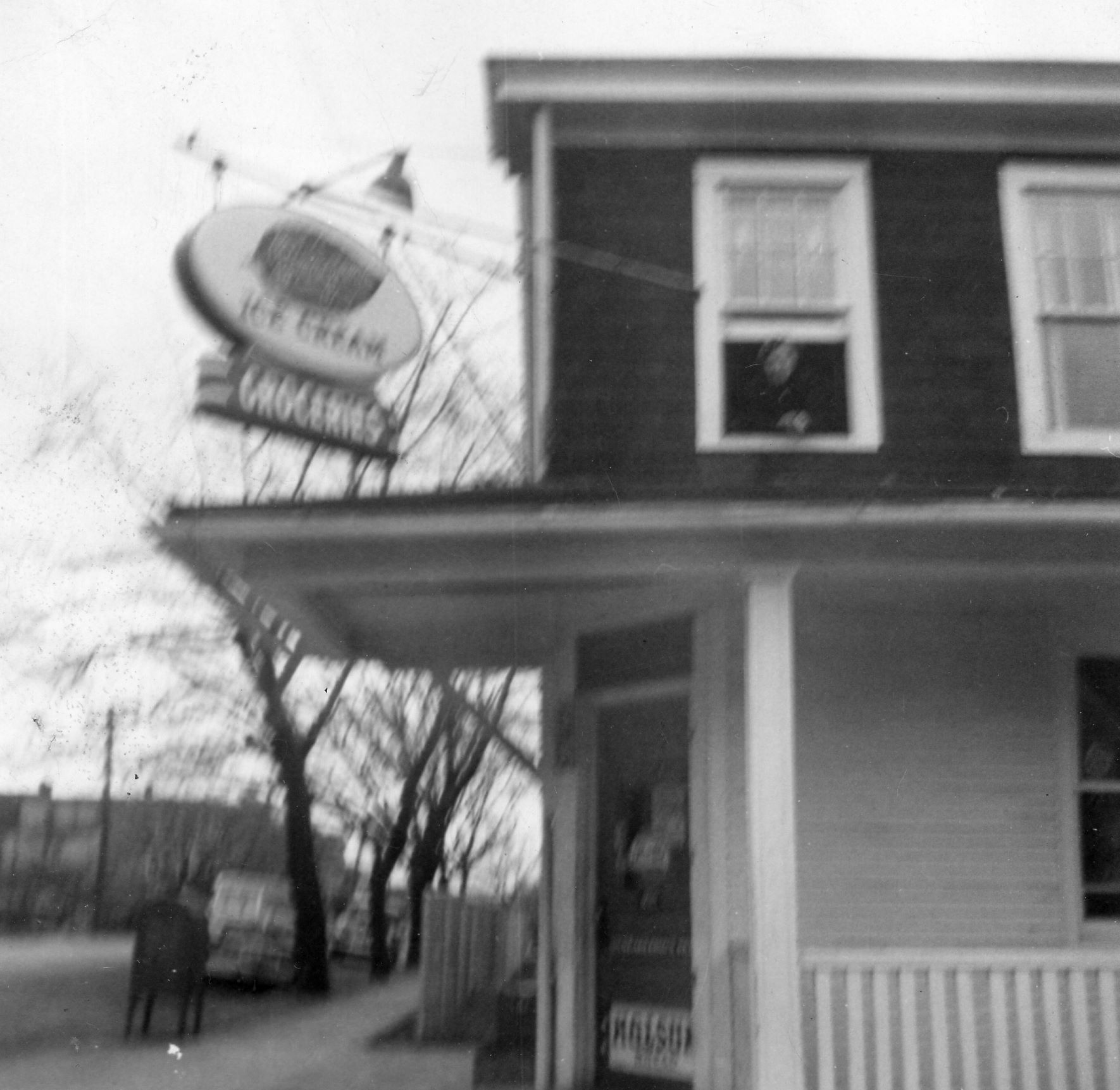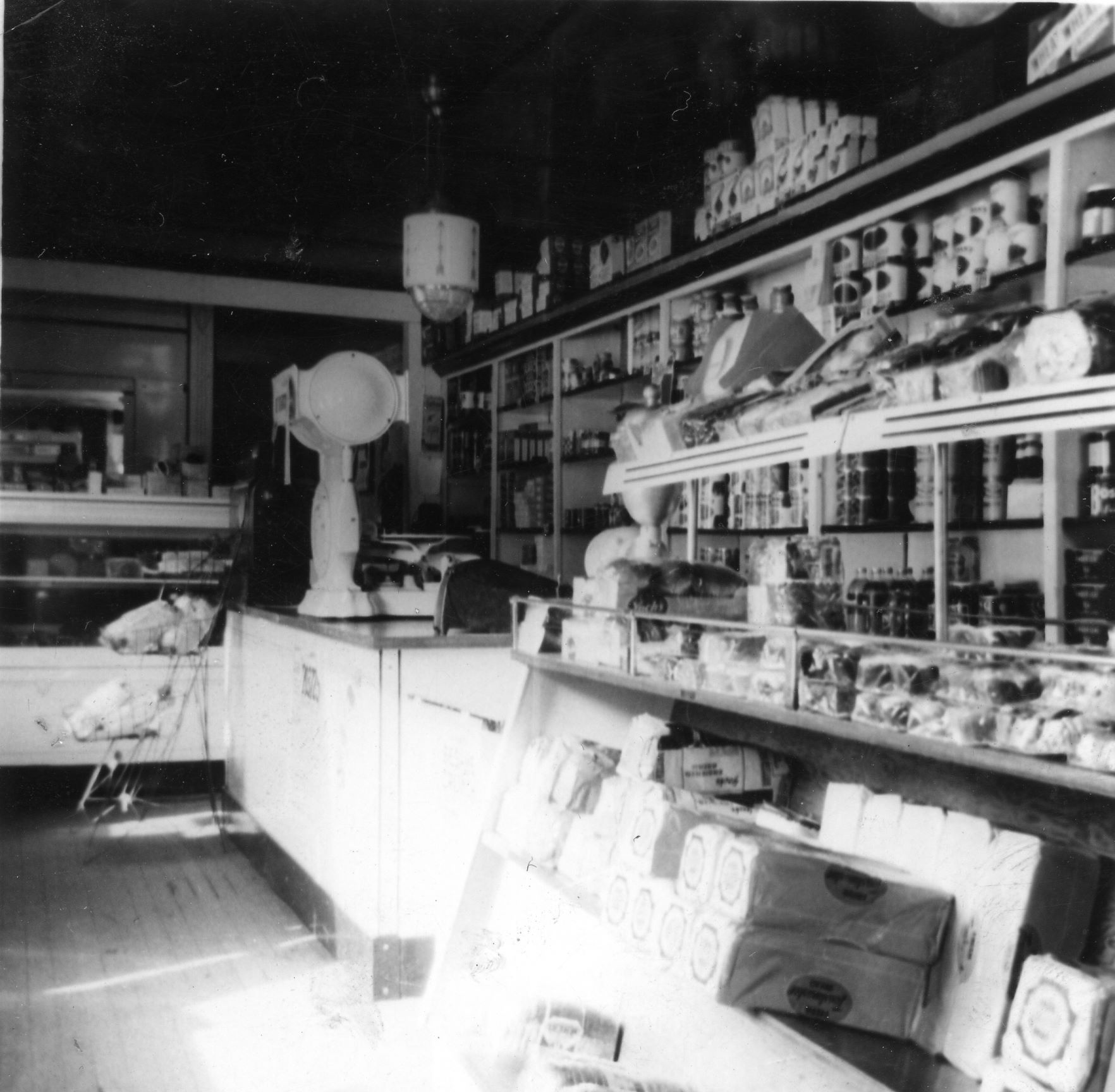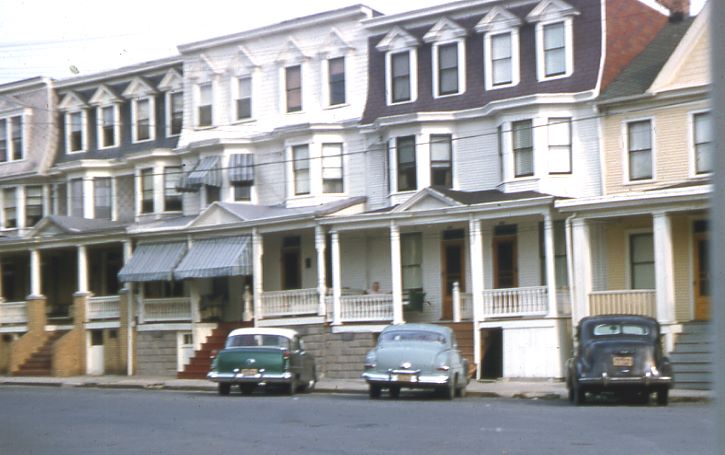|
The store was located on the corner of 6th and Walnut Streets. The above view looks down 6th Street towards Chestnut. There was an abundance of grocery stores in Mount Carmel. In a three block span on either side of the Hook store, there were six stores selling groceries. But among them only one other could compete with the Hook store for offering a full range of products.... Howenstien's between Chestnut and Market Streets.
The photo was most likely taken in the mid 1930's. By 1940 the Breyer's ice cream sign was removed as was the railings onn the porch. The sale of ice cream was likely eliminated because a Hook household of six children would surely have depressed profit margins.
The store was open till 9:00 PM on Saturdays but closed all day Sunday and after 12:00 noon on Wednesday. Otherwise closing time was 5:00 PM. These were typical hourS for almost all stores in town.
During the Christmas season trees were sold. The trees were stacked along the 6th Street side wall... In the evening, at closing time. all unsold trees were hauled into the basement entry way at the front of the house. Those short tree needles fell off in great profusion on each trip.
The person looking out the window will likely never be identified
|
|
This interior view looks toward the entrance on the right. Canned goods were stocked on shelves on the left that ran the full length of the store. Almost any canned item was available ...but only one brand. Toilet tissue was stocked on the highest shelf in upper right corner. Only one brand, Waldorf, was avaiable and it had a texture that was only one notch better than Sears catalog pages.
The counter to the left offered a variety of breads on the lower shelves and cakes and pastries above. Tasty Kakes and Wonder bread were popular items. On the back side lower shelves 0f that bakery stand wre a large variety of tobacco products.
Hanging forlornly in front of the window is an empty banana stock. They were pulled off the stock for sale one at a time. If they turned brown the Hook family members could expect banana cake for dessert.
Against the back wall were bins and shelves for produce. fruits on the top shelves, root vegetables in the lower bins and various greens in the center. There was no refrigeratation and the store was not air conditioned. Consequently, stuff could turn nasty looking rather quickly. Fruit flies were a mostly uncontrollable problem. Sticky ribbon fly traps were hung from strategically placed ceiling locations during warm weather months.
The ceiling was covered with varnished plywood panels. The joints were covered with black painted thin strips.
Blocked from view is a pay phone attached to the wall immediately to the left as you enter the door. The phone number was just 4 digits long. a dime was required to make a call. A long distance call, anything not not on tne Shamoken/Mount Carmel exchage, had to be made by first dialing the operator who then made the connection. The Hook family had no phone in their residance.
The shelves in the left foreground usually held items in glass jars, such as jams, peanut butter, condiments, pickles, olive, etc.
Between the door and those foreground shelves ws a large 4X5 window. Beneath it was an equally long steam radiator. Heat was provided by a large coal fired furnace in the basement that allso heated the entire hook residence
Obviously this was not a self service store.
|
|
In this photo, the left forground shows the baked goods stand shown in the previous photograph. Beyond that, on a difficult to discern wooden stand, sat a massive, (by todays standards}, coffee grinder. Pre-ground coffee was available in cans not unlike those used today.
The long counter beyond that held a scale and a cash register. The scale was, naturally, entirely mechanical and used for a surprising number of purchases
Beneath the counter was a series of large wooden drawers that contained, mostly, various kinds of dried beans. They were scooped in brown paper sacks in whatever amounts the customer desired.
The cash register sat on the far right of the counter. As a customer selected items it was placed on the counter and its cost was written on a paper bag. When selecting was completed the total cost was tallied and that amount was entered into the cash register. A lever was pulled, accompanied by a resounding DING, and the cash drawer sprang out. The customer's money was placed into the appropriate places, change made, products bagged and the customer departed with a grateful thank you. At closing time the cas register cranked out the total amount of sales for the day.
There were of course, no credit cards in those days. But customers could by stuff "on tick" with payment being made at a later date, typically a payday. In those days Tasty Kakes were delivvered to the store in boxes that had cardboard seperators between the cakes to limit squashing. It was these seperators that were used to record credit transactions.
Beyond the counter to the left is a half visable refridgerated deli case. Popular cold cuts and cheeeses were sliced and weighed in accordance with the customer's wishes. Milk and soft drinks were maintained in compartments underneath.
Out of sight to the left, in front of the deli case was a rack for six boxes, each containing a different variety of cookie. These were sold loose, collected with bare hands and placed in one of those ubiquitous brown paper bags. Potato chips were sold the same way from large two foot tall tins.
Continuing back beyond the deli case was a massive walk-in refrigerator. Essentially the store had grocery, produce, deli, bakery, dairy and meat deparments. Meats were ordered from local slaughter houses as a half steer or half hog. Consequently the store was equipped with an array of cutting tools, a meat band saw, a grinder for hamburg, and a press for making sausage. The walk-in refridgerater also supported the requirements of the Hook catering business. Chops, steaks, roasts were cut as customers ordered them.
Beyond the refridgerator, at the far end of the store, was amall storage room. Grocery items for which there was no shelf space up front were stored here as well as some larger flour sacks. Most prominent were two full size four foot tall barrels. One contained vinegar, the other molasses. Each was equipped with a hand pump. Purchasers were required to bring their own conainers.
The floor of the store was bare wood. Once a week some kind of green granular material was spread on the floor and shortly afterward swept up and discarded.
All in all the store served the neighberhood quite well. But by today's standards it would be a germaphobes worst nightmare.
|
|
THe store had a large 4' X 5' window that looked out onto 6th Street. The above photo shows what one would see looking out that window. Those row homes are mostly East of Walmut Street.
Now, what was once a saloon, then a grocery store, now contains a dining area, a bathroom, and a large family type room.
|



